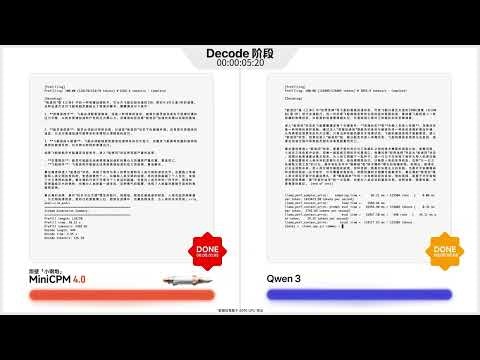Table of Contents
Overview
In the ever-evolving landscape of artificial intelligence, the demand for efficient and accessible AI solutions is skyrocketing. Enter MiniCPM 4.0, a suite of open-source language models designed to bring the power of AI directly to your devices. Developed by THUNLP (Tsinghua University Natural Language Processing Lab), Renmin University of China, and ModelBest, MiniCPM prioritizes speed, efficiency, and a compact size. Let’s dive into what makes MiniCPM a noteworthy contender in the world of AI tools.
Key Features
MiniCPM 4.0 boasts a compelling set of features tailored for on-device AI:
- Ultra-efficient language models: MiniCPM4-8B (8B parameters) and MiniCPM4-0.5B (0.5B parameters) designed for optimal performance on resource-constrained devices, ensuring smooth operation without sacrificing functionality.
- Designed for on-device use: Specifically engineered to run directly on your devices, eliminating the need for cloud connectivity in many applications.
- Open-source: Fully accessible and customizable, empowering developers to adapt the models to their specific needs and contribute to the community.
- BitCPM quantized variants: Achieve 90% reduction in bit width through extreme ternary quantization, minimizing resource usage for ultra-low-power devices.
- Industry-leading speed: Delivers over 5x generation speed-ups on typical edge hardware compared to conventional models.
- High performance on edge chips: Optimized to leverage the capabilities of edge computing hardware, delivering impressive results in real-world scenarios.
- Developed by OpenBMB: Backed by a reputable organization dedicated to advancing open-source AI research and development.
How It Works
The magic behind MiniCPM lies in its architecture and training methodology. These models are meticulously trained to be lightweight and exceptionally fast, enabling them to operate efficiently on devices with limited computing power. The BitCPM variants take this a step further by employing quantization techniques. Quantization reduces the size of the model and enhances its speed, all while striving to maintain competitive accuracy. This allows developers to seamlessly deploy MiniCPM models directly on mobile devices, IoT gadgets, or other edge hardware, bringing AI capabilities closer to the user.
Use Cases
The versatility of MiniCPM opens up a wide array of potential applications:
- Mobile apps with embedded AI: Integrate AI-powered features directly into your mobile applications, such as intelligent text completion or personalized recommendations.
- IoT devices: Enhance the functionality of IoT devices with AI capabilities, enabling them to make smarter decisions and respond more effectively to their environment.
- AI assistants on smartphones: Power on-device AI assistants that can understand and respond to user commands without relying on a constant internet connection.
- Smart home integrations: Create more intelligent and responsive smart home systems that can learn user preferences and automate tasks.
- Offline LLM tools: Develop tools that can process and generate text even without an internet connection, ensuring accessibility in any situation.
Pros & Cons
Like any technology, MiniCPM has its strengths and weaknesses. Understanding these can help you determine if it’s the right tool for your project.
Advantages
- High efficiency and speed: Delivers impressive performance on resource-constrained devices, making it ideal for on-device applications.
- Open-source accessibility: Provides full access to the model’s code, allowing for customization and community contributions.
- Strong on-device performance: Optimized for running directly on devices, eliminating the need for cloud connectivity in many cases.
- Quantized options: BitCPM variants offer even greater efficiency and speed through quantization techniques.
Disadvantages
- May lack the depth of larger models: Compared to larger language models, MiniCPM may have limitations in terms of complexity and reasoning abilities.
- Less suited for complex reasoning tasks: While efficient, it might not be the best choice for tasks requiring advanced reasoning or problem-solving.
- Requires model adaptation for specific use cases: Depending on the application, some fine-tuning or adaptation may be necessary to achieve optimal results.
- Technical expertise required: Deployment and integration require some technical knowledge and familiarity with edge computing environments.
How Does It Compare?
When considering on-device AI solutions, it’s essential to compare MiniCPM with its competitors:
- Llama.cpp: While Llama.cpp offers more mature tooling, it generally has a larger footprint compared to MiniCPM, making it less suitable for extremely resource-constrained devices.
- Mistral: Mistral boasts higher overall performance, but it’s less optimized for edge computing and on-device deployment compared to MiniCPM.
- TinyLLaMA: TinyLLaMA is similarly compact, but it hasn’t achieved the same level of widespread adoption and community support as MiniCPM.
Final Thoughts
MiniCPM 4.0 presents a compelling solution for developers seeking to bring the power of AI to on-device applications. Its focus on efficiency, open-source accessibility, and quantized options makes it a strong contender in the rapidly evolving landscape of edge AI. While it may not be suitable for the most complex reasoning tasks, its strengths in speed and resource efficiency make it an excellent choice for a wide range of use cases, from mobile apps to IoT devices. As the demand for on-device AI continues to grow, MiniCPM is well-positioned to play a significant role in shaping the future of intelligent devices.
